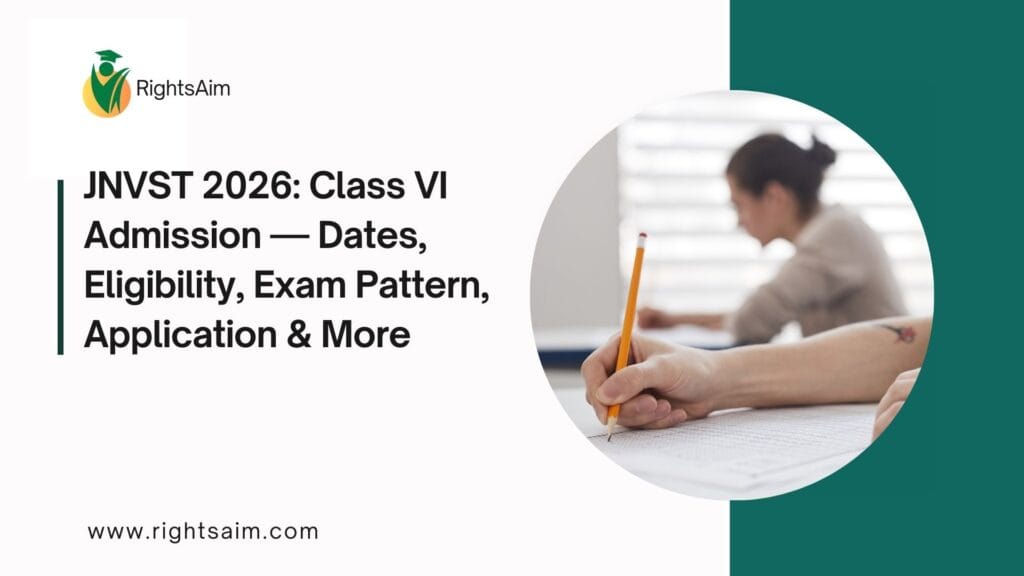
Table of Contents
2. What Are Jawahar Navodaya Vidyalayas (JNVs)?
Established under the Ministry of Education, JNVs are co-ed, CBSE-affiliated residential schools targeting meritorious students from rural areas across India.
Free education, boarding, lodging, uniforms, and textbooks are provided; nominal fees apply only from Class IX onwards, with exemptions for SC/ST, girls, BPL, and Divyang students.
Highly competitive: e.g. in 2021, only ~1.95% of over 24 lakh applicants were selected.
3. JNVST 2026: Key Dates & Application Timeline
| Event | Date |
|---|---|
| Notification Release | June 2, 2025 |
| Application Start | June 1 / 30 May 2025 |
| Final Application Deadline | July 29, 2025 (extended to August 27) |
| Phase 1 Exam (Summer-bound) | December 13, 2025 (11:30 AM) |
| Phase 2 Exam (Winter-bound) | April 11, 2026 (11:30 AM) |
| Phase 1 Result | January 2026 (expected) |
| Phase 2 Result | May 2026 (expected) |
The application window initially closed on July 29, then extended to August 27—giving candidates extra time to apply.
4. Who Is Eligible to Apply?
Current Class V students belonging to the same district as the desired JNV only.
Date of Birth must fall between May 1, 2014 and July 31, 2016 (both inclusive).
5. How to Apply: Step-by-Step Guide
Visit the official portals: navodaya.gov.in or cbseitms.rcil.gov.in/nvs.
Complete the online application by providing personal and academic details. Upload:
Passport-size photograph
Signatures (student and parent)
Certificates (Aadhaar, residence, birth, rural, caste, medical fitness as applicable)
Submit the form and save the acknowledgment for future reference.
6. Exam Structure & Pattern for Class VI
The JNVST paper divides into three sections with no negative marking:
| Section | Questions | Marks | Time |
|---|---|---|---|
| Mental Ability Test | 40 | 50 | 60 minutes |
| Arithmetic Test | 20 | 25 | 30 minutes |
| Language Test | 20 | 25 | 30 minutes |
| Total | 80 | 100 | 120 minutes |
An additional 40 minutes is allotted to differently-abled candidates.
7. Two-Phase Exam: What You Need to Know
Phase 1 (Summer-bound areas): Held on Dec 13, 2025.
Phase 2 (Winter-bound/hilly regions): Held on Apr 11, 2026.
Results are released in Jan 2026 and May 2026 respectively.
8. Documents Required for Registration & Exam Day
Birth Certificate, Aadhaar or Residence proof, Rural Certificate (if applicable)
Caste Certificate (if applicable), Medical Fitness Certificate, Signature files, and Photograph uploads during form fill-up.
Carry valid admit card and identity proof on exam day. (While not explicitly cited here, these are standard requirements.)
9. Post-Exam: Results and Selection Process
Results are expected in January 2026 (Phase 1) and May 2026 (Phase 2).
Selections are merit-based with reservations for ST/SC, rural quota (75%), female candidates (33%), and Divyang (3%) as per NVS policy.
10. FAQs
Q1. What is JNVST 2026?
→ JNVST 2026 is the Class VI admission entrance exam for Navodaya Vidyalayas conducted in Dec 2025 and April 2026.
Q2. When is the last date to apply?
→ Extended till August 27, 2025.
Q3. Who can apply?
→ Class V students from the same district, born between May 1, 2014 and July 31, 2016.
Q4. What is the exam pattern?
→ 80 questions across three sections (Mental Ability, Arithmetic, Language), total 100 marks, 2-hour duration.
Q5. How many phases does the exam have?
→ Two—Phase 1 on Dec 13, 2025, and Phase 2 on April 11, 2026.
11. Conclusion
JNVST 2026 opens a pathway for rural Class V students to access quality education via Jawahar Navodaya Vidyalayas. With notification released, application window extended, and exam scheduled into two phases, candidates have structured timelines to follow. Careful preparation, timely application, and understanding the pattern could be key to success.
